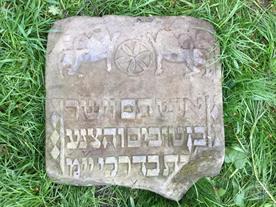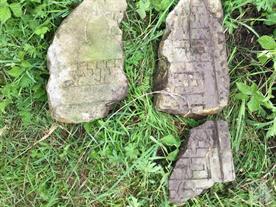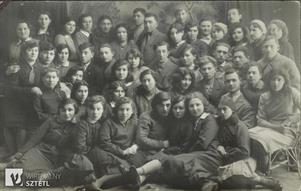Berestechko
Lutsk district, Volyn region
Sources:
- Jewish encyclopedia of Brockhaus & Efron;
- Russian Jewish encyclopedia;
- Virtual Shtetl. Berestechko;
- Holocaust in the USSR: Encyclopedia / Scientific and Educational Center "Holocaust"; ch. editor Ilya Altman. - Moscow: Rosspen, 2011 - 1143 p.
- Weiss A., Spector S., Berestechko, [in:] Encyclopaedia Judaica, Second Edition, ed. F. Skolnik, M. Berenbaum, Vol. 3, Detroit–New York–San Francisco–New Haven–Waterville–London 2007.
- The All South-Western Territory: reference and address book of the Kyiv, Podolsk and Volyn provinces. Printing house L.M. Fish and P.E. Wolfson, 1913.
Photo:
- European Jewish Cemeteries Initiative. Berestechko Jewish Cemetery;
- Vanished World Berestechko synagogue
- Щербатюк Сергій, Википедия. Музична школа (колишня синагога)
- Muzeum Historii Żydów Polskich POLIN
- Jewish encyclopedia of Brockhaus & Efron;
- Russian Jewish encyclopedia;
- Virtual Shtetl. Berestechko;
- Holocaust in the USSR: Encyclopedia / Scientific and Educational Center "Holocaust"; ch. editor Ilya Altman. - Moscow: Rosspen, 2011 - 1143 p.
- Weiss A., Spector S., Berestechko, [in:] Encyclopaedia Judaica, Second Edition, ed. F. Skolnik, M. Berenbaum, Vol. 3, Detroit–New York–San Francisco–New Haven–Waterville–London 2007.
- The All South-Western Territory: reference and address book of the Kyiv, Podolsk and Volyn provinces. Printing house L.M. Fish and P.E. Wolfson, 1913.
Photo:
- European Jewish Cemeteries Initiative. Berestechko Jewish Cemetery;
- Vanished World Berestechko synagogue
- Щербатюк Сергій, Википедия. Музична школа (колишня синагога)
- Muzeum Historii Żydów Polskich POLIN
Berestechko, the city (since 1940), founded in 1445. In the 16-18 centuries - in the Volyn Voivodeship as part of the Commonwealth. From 1795 - as part of the Russian Empire. In the 19th - beginning of the 20th century - the township of Dubno district of the Volyn province.
In 1765, 632 Jews lived in Berestechko (total 872 Jews in Berestechko kahal, which included nearby villages);
in 1787 - 569 Jews (total 790 in kahal);
in 1847 - 1927 Jews (876 men and 1051 women);
in 1897 - 2251 (54.4% of total population);
in 1921 - 1975 (35%);
in 1931 - 2210 (35%);
in 1937 - 2625 Jews (35%).
The earliest mention of Jews in Berestechko dates back to 1569. In 1648, their number amounted to 1,000. Around 200 families died during pogroms perpetrated by Khmelnytsky's Cossacks; only 12 Jewish households survived. Approximately one thousand Jews fought on the Polish side against Cossacks and Tatars in the great battle of 1651.
At the beginning of the 18th century, the rabbi was Szaul ben Jaakow, in the 1850s and 1860s - Eliezer Lipman, and at the turn of the 18th and 19th centuries - Chaim-Mordche Margaliot (died in 1818). Almost all Jews perished in the plague epidemic at the end of the 17th century.
In 1765, 632 Jews lived in Berestechko (total 872 Jews in Berestechko kahal, which included nearby villages);
in 1787 - 569 Jews (total 790 in kahal);
in 1847 - 1927 Jews (876 men and 1051 women);
in 1897 - 2251 (54.4% of total population);
in 1921 - 1975 (35%);
in 1931 - 2210 (35%);
in 1937 - 2625 Jews (35%).
The earliest mention of Jews in Berestechko dates back to 1569. In 1648, their number amounted to 1,000. Around 200 families died during pogroms perpetrated by Khmelnytsky's Cossacks; only 12 Jewish households survived. Approximately one thousand Jews fought on the Polish side against Cossacks and Tatars in the great battle of 1651.
At the beginning of the 18th century, the rabbi was Szaul ben Jaakow, in the 1850s and 1860s - Eliezer Lipman, and at the turn of the 18th and 19th centuries - Chaim-Mordche Margaliot (died in 1818). Almost all Jews perished in the plague epidemic at the end of the 17th century.
The Soviet occupation which began in September 1939 was a serious blow to the community. All commercial and manufacturing activities were nationalized, political parties and social organizations were banned, and all independent institutions were closed. The Hebrew school was converted into a school with Yiddish as the language of instruction.
Germans entered the town on June 23, 1941. A number of repressive measures against Jews were immediately introduced, such as: the obligation to wear a mark on clothes in the form of the Star of David (later the yellow armband); being forced to work hard without any pay; looting and rapes, committed in particular by the Ukrainian police.
As early as August 8 of that year, the German police (SD from Lutsk), assisted by the Ukrainians, carried out a mass execution of 300 men of Jewish nationality near the Beresteczko castle. A Judenrat was established, with the task of collecting a high contribution.
On October 5-14, 1941, a ghetto was established. Jews from nearby towns were also driven there, while some craftsmen were allowed to stay outside the closed district. The ghetto was liquidated on September 7-9, 1942. SD units, supported by the Ukrainian police, shot about 3,000 people. The place of extermination was primarily Jar, located 2 km from the town. Only a few who managed to escape survived the crime of genocide.
A few Jews appeared in the town after the entry of Red Army troops on April 24, 1944. They found that their homes were destroyed.
Germans entered the town on June 23, 1941. A number of repressive measures against Jews were immediately introduced, such as: the obligation to wear a mark on clothes in the form of the Star of David (later the yellow armband); being forced to work hard without any pay; looting and rapes, committed in particular by the Ukrainian police.
As early as August 8 of that year, the German police (SD from Lutsk), assisted by the Ukrainians, carried out a mass execution of 300 men of Jewish nationality near the Beresteczko castle. A Judenrat was established, with the task of collecting a high contribution.
On October 5-14, 1941, a ghetto was established. Jews from nearby towns were also driven there, while some craftsmen were allowed to stay outside the closed district. The ghetto was liquidated on September 7-9, 1942. SD units, supported by the Ukrainian police, shot about 3,000 people. The place of extermination was primarily Jar, located 2 km from the town. Only a few who managed to escape survived the crime of genocide.
A few Jews appeared in the town after the entry of Red Army troops on April 24, 1944. They found that their homes were destroyed.
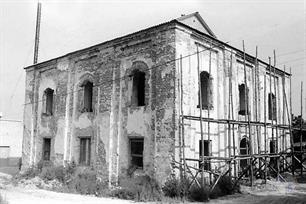 |
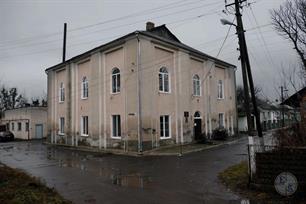 |
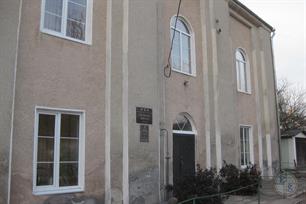 |
| Synagogue in Berestechko, post -war restoration. It was built in 1885 | As of 2018, a music school was located in the building | There is an information nameplate on the building |
In the 19th century, the community revived, taking advantage of the gradual improvement in the economic situation in the territories of the Russian Partition. Approx. in 1850, there were 4 synagogues in the town, including two Hasidic ones.
In the period 1881–1937 the rabbi was Mosze-Lejb Kliwaner, while Nachman Zwagiler was considered the leader of the Hasidim.
In 1901, according to records, there was a Jewish school of I.Kagan for boys, a hospital, an almshouse and a Jewish library.
At the beginning of the 20th century, the Bund and youth Zionist organizations became active.
In 1913, Jews owned only farmacy and warehouse of pharmacy goods, both photo studios sand all 26 shops in Berestechko.
The Jew Mendl Galperson was only dentist in the township.
In the period 1881–1937 the rabbi was Mosze-Lejb Kliwaner, while Nachman Zwagiler was considered the leader of the Hasidim.
In 1901, according to records, there was a Jewish school of I.Kagan for boys, a hospital, an almshouse and a Jewish library.
At the beginning of the 20th century, the Bund and youth Zionist organizations became active.
In 1913, Jews owned only farmacy and warehouse of pharmacy goods, both photo studios sand all 26 shops in Berestechko.
The Jew Mendl Galperson was only dentist in the township.

- Home
- Shtetls
- Vinnytsia region
- Volyn region
- Dnipro region
- Donetsk region
- Zhytomyr region
- Zakarpattia region
- Zaporizhzhia region
- Ivano-Frankivsk region
- Kyiv region
- Kropyvnytskyi region
- Luhansk region
- Lviv region
- Mykolayiv region
- Odessa region
- Poltava region
- Rivne region
- Sumy region
- Ternopil region
- Kharkiv region
- Kherson region
- Khmelnytskyi region
- Chernihiv region
- Chernivtsi region
- Cherkasy region
- Crimea
- Synagogues
- Cemeteries
- Objects & guides
- Old photos
- History
- Contact
Jewish towns of Ukraine
My shtetl
My shtetl
Donate
Jewish towns of Ukraine
